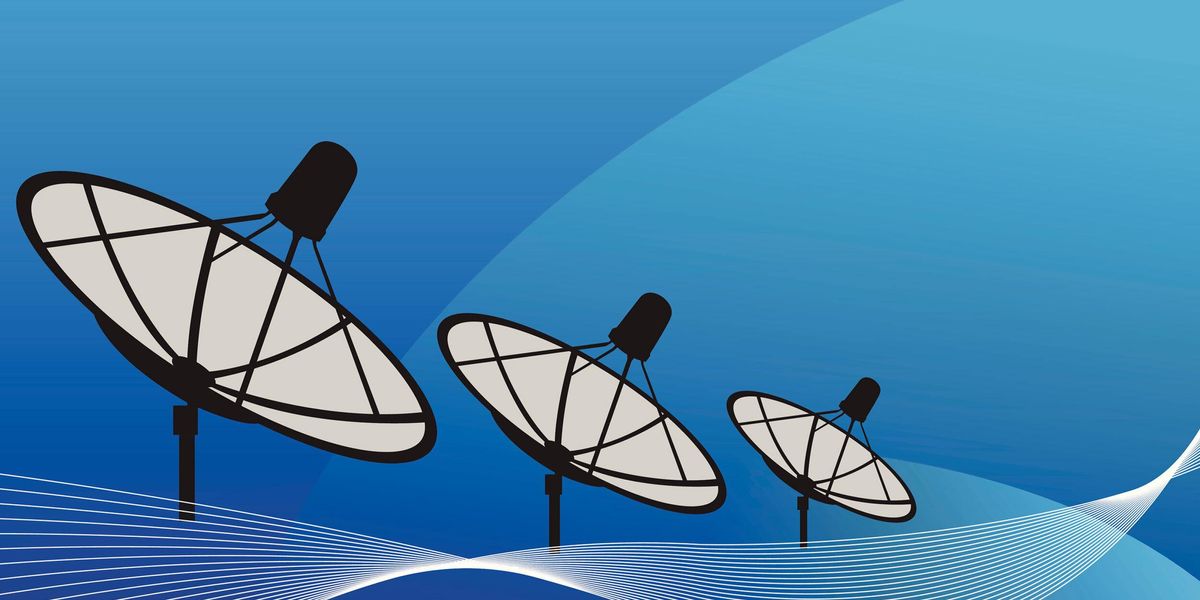In
our pilot examine, we draped a skinny, versatile electrode array around the surface of the volunteer’s brain. The electrodes recorded neural signals and despatched them to a speech decoder, which translated the signals into the phrases the man meant to say. It was the to start with time a paralyzed particular person who could not speak experienced applied neurotechnology to broadcast total words—not just letters—from the brain.
That demo was the fruits of additional than a 10 years of investigation on the underlying brain mechanisms that govern speech, and we’re enormously proud of what we have completed so significantly. But we’re just finding started.
My lab at UCSF is doing work with colleagues all around the planet to make this technologies safe, secure, and reputable more than enough for day to day use at home. We’re also performing to boost the system’s functionality so it will be truly worth the energy.
How neuroprosthetics do the job
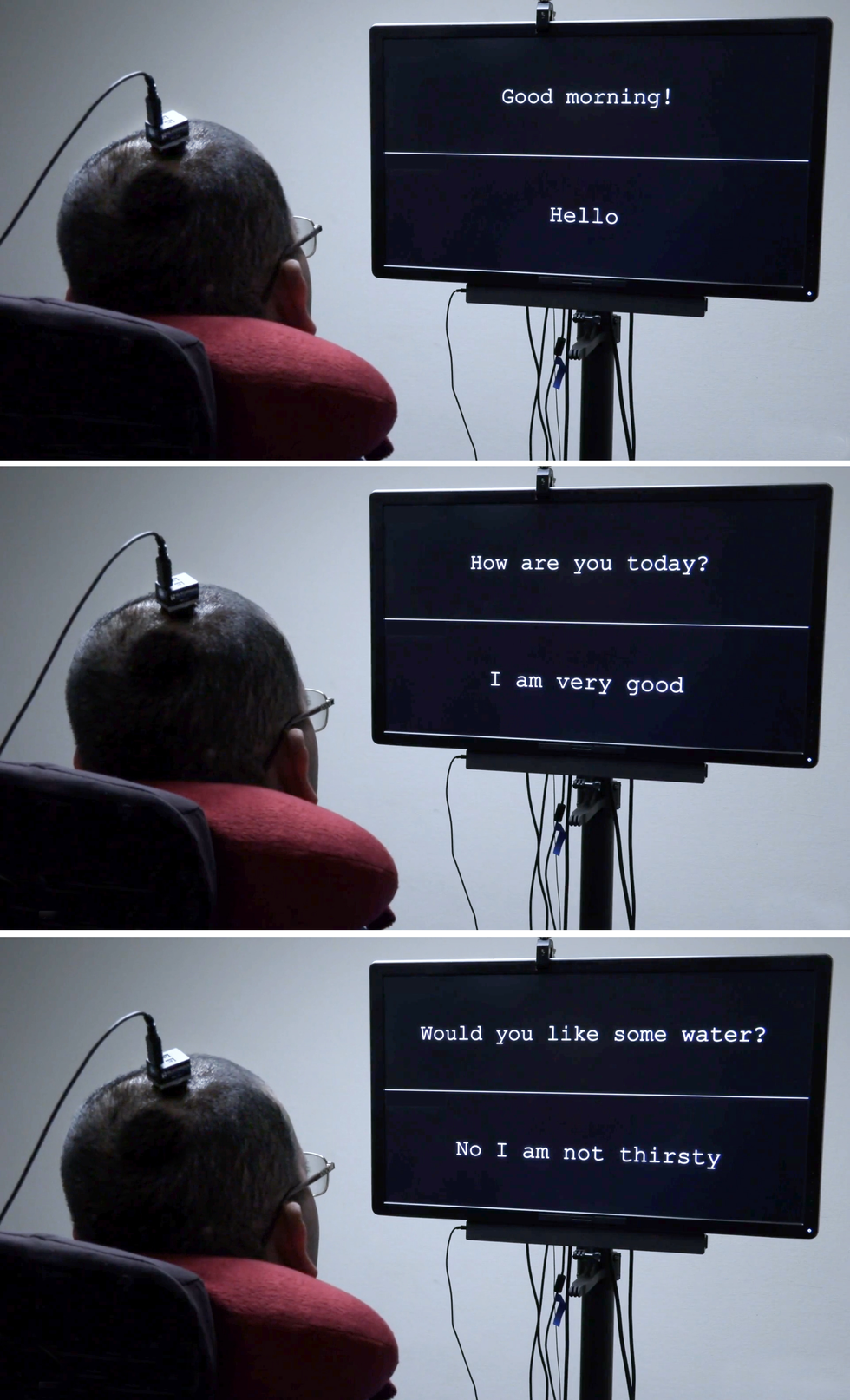 The 1st variation of the brain-computer system interface gave the volunteer a vocabulary of 50 practical phrases. University of California, San Francisco
The 1st variation of the brain-computer system interface gave the volunteer a vocabulary of 50 practical phrases. University of California, San Francisco
Neuroprosthetics have arrive a prolonged way in the previous two a long time. Prosthetic implants for listening to have state-of-the-art the furthest, with patterns that interface with the
cochlear nerve of the inner ear or immediately into the auditory mind stem. There is also significant investigate on retinal and brain implants for vision, as very well as initiatives to give men and women with prosthetic palms a perception of contact. All of these sensory prosthetics just take data from the outside the house globe and transform it into electrical signals that feed into the brain’s processing facilities.
The reverse form of neuroprosthetic records the electrical action of the mind and converts it into alerts that handle anything in the outdoors earth, this kind of as a
robotic arm, a movie-match controller, or a cursor on a laptop display. That previous regulate modality has been employed by groups these kinds of as the BrainGate consortium to allow paralyzed people today to form words—sometimes one particular letter at a time, in some cases working with an autocomplete function to speed up the process.
For that typing-by-brain function, an implant is typically positioned in the motor cortex, the portion of the brain that controls motion. Then the consumer imagines selected actual physical steps to control a cursor that moves more than a virtual keyboard. A different strategy, pioneered by some of my collaborators in a
2021 paper, had one particular user picture that he was keeping a pen to paper and was producing letters, producing indicators in the motor cortex that had been translated into textual content. That approach established a new file for pace, enabling the volunteer to write about 18 words and phrases for every minute.
In my lab’s exploration, we have taken a far more ambitious strategy. Instead of decoding a user’s intent to shift a cursor or a pen, we decode the intent to command the vocal tract, comprising dozens of muscles governing the larynx (usually called the voice box), the tongue, and the lips.
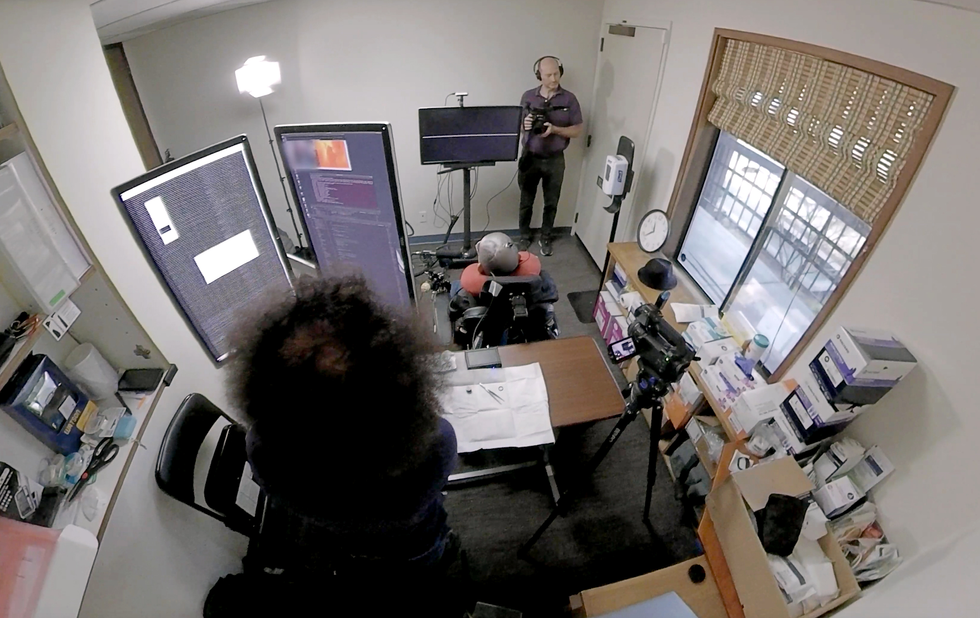 The seemingly uncomplicated conversational setup for the paralyzed man [in pink shirt] is enabled by each advanced neurotech components and device-understanding methods that decode his brain signals. College of California, San Francisco
The seemingly uncomplicated conversational setup for the paralyzed man [in pink shirt] is enabled by each advanced neurotech components and device-understanding methods that decode his brain signals. College of California, San Francisco
I commenced doing the job in this place far more than 10 several years back. As a neurosurgeon, I would typically see clients with intense accidents that still left them unable to discuss. To my shock, in lots of circumstances the spots of mind injuries didn’t match up with the syndromes I uncovered about in healthcare school, and I realized that we however have a ton to study about how language is processed in the brain. I decided to research the underlying neurobiology of language and, if doable, to build a mind-device interface (BMI) to restore interaction for men and women who have shed it. In addition to my neurosurgical background, my workforce has knowledge in linguistics, electrical engineering, pc science, bioengineering, and medicine. Our ongoing scientific demo is screening both components and computer software to investigate the restrictions of our BMI and ascertain what form of speech we can restore to people today.
The muscle tissues associated in speech
Speech is one particular of the behaviors that
sets humans aside. Loads of other species vocalize, but only individuals mix a set of sounds in myriad unique ways to characterize the earth all around them. It is also an extraordinarily complex motor act—some professionals think it’s the most advanced motor motion that men and women accomplish. Speaking is a item of modulated air flow by means of the vocal tract with each individual utterance we shape the breath by creating audible vibrations in our laryngeal vocal folds and transforming the form of the lips, jaw, and tongue.
Lots of of the muscle groups of the vocal tract are pretty in contrast to the joint-dependent muscles these types of as people in the arms and legs, which can go in only a handful of prescribed techniques. For illustration, the muscle mass that controls the lips is a sphincter, although the muscular tissues that make up the tongue are governed much more by hydraulics—the tongue is mostly composed of a preset quantity of muscular tissue, so going one particular component of the tongue adjustments its condition elsewhere. The physics governing the movements of such muscle mass is completely different from that of the biceps or hamstrings.
Simply because there are so several muscle tissue associated and they each have so several levels of liberty, there’s essentially an infinite number of probable configurations. But when people today discuss, it turns out they use a relatively compact established of main actions (which vary rather in diverse languages). For instance, when English speakers make the “d” sound, they put their tongues behind their enamel when they make the “k” seem, the backs of their tongues go up to touch the ceiling of the again of the mouth. Number of persons are acutely aware of the precise, advanced, and coordinated muscle steps essential to say the easiest term.
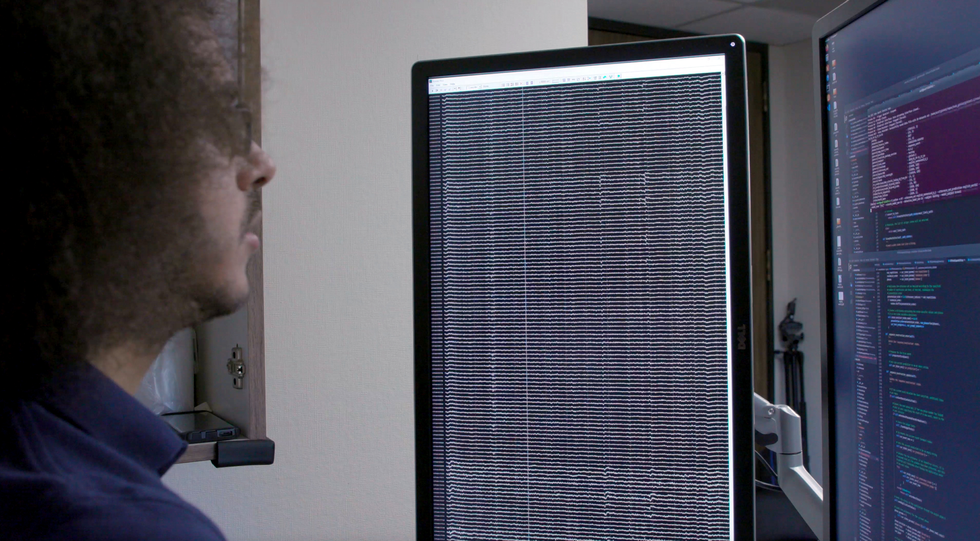 Team member David Moses seems to be at a readout of the patient’s mind waves [left screen] and a exhibit of the decoding system’s activity [right screen].College of California, San Francisco
Team member David Moses seems to be at a readout of the patient’s mind waves [left screen] and a exhibit of the decoding system’s activity [right screen].College of California, San Francisco
My study team focuses on the pieces of the brain’s motor cortex that send motion commands to the muscles of the experience, throat, mouth, and tongue. These brain regions are multitaskers: They take care of muscle actions that develop speech and also the movements of those people exact muscle mass for swallowing, smiling, and kissing.
Researching the neural activity of all those regions in a useful way demands equally spatial resolution on the scale of millimeters and temporal resolution on the scale of milliseconds. Traditionally, noninvasive imaging devices have been capable to deliver 1 or the other, but not each. When we started out this study, we discovered remarkably minor facts on how brain activity patterns were connected with even the simplest components of speech: phonemes and syllables.
Listed here we owe a debt of gratitude to our volunteers. At the UCSF epilepsy center, sufferers getting ready for operation typically have electrodes surgically put more than the surfaces of their brains for quite a few times so we can map the regions involved when they have seizures. All through these several days of wired-up downtime, a lot of sufferers volunteer for neurological research experiments that make use of the electrode recordings from their brains. My group questioned clients to allow us analyze their designs of neural action when they spoke terms.
The components concerned is called
electrocorticography (ECoG). The electrodes in an ECoG system don’t penetrate the brain but lie on the surface area of it. Our arrays can incorporate many hundred electrode sensors, every single of which documents from hundreds of neurons. So significantly, we’ve used an array with 256 channels. Our intention in people early reports was to find the styles of cortical activity when people communicate very simple syllables. We questioned volunteers to say specific seems and phrases though we recorded their neural designs and tracked the movements of their tongues and mouths. Sometimes we did so by having them dress in colored encounter paint and utilizing a laptop or computer-vision program to extract the kinematic gestures other times we employed an ultrasound equipment positioned below the patients’ jaws to image their moving tongues.
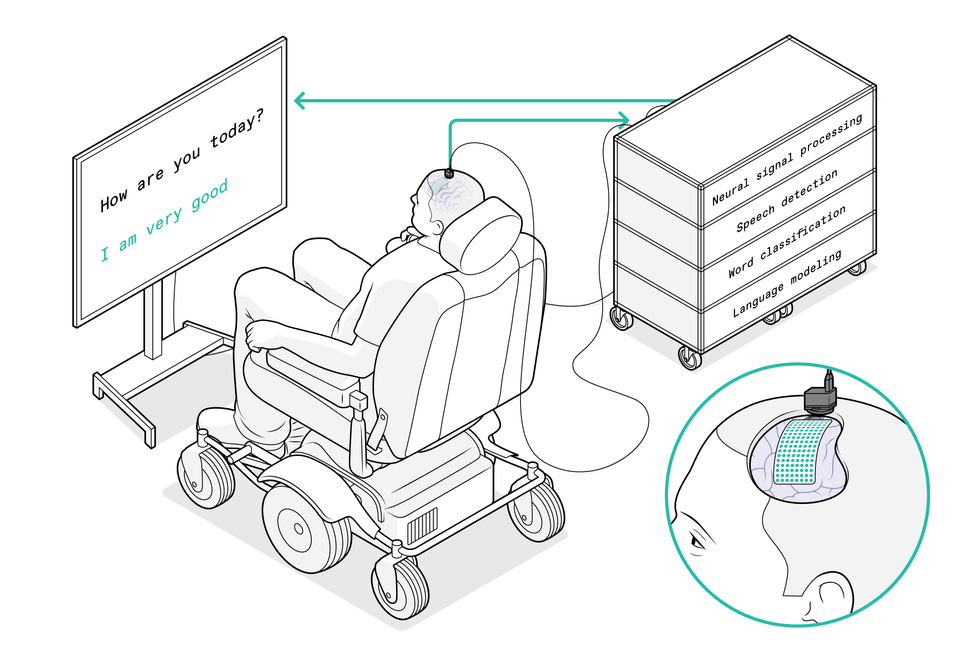 The method commences with a flexible electrode array which is draped more than the patient’s mind to pick up indicators from the motor cortex. The array specially captures motion instructions supposed for the patient’s vocal tract. A port affixed to the cranium guides the wires that go to the pc method, which decodes the brain alerts and translates them into the words and phrases that the individual needs to say. His responses then look on the exhibit display.Chris Philpot
The method commences with a flexible electrode array which is draped more than the patient’s mind to pick up indicators from the motor cortex. The array specially captures motion instructions supposed for the patient’s vocal tract. A port affixed to the cranium guides the wires that go to the pc method, which decodes the brain alerts and translates them into the words and phrases that the individual needs to say. His responses then look on the exhibit display.Chris Philpot
We made use of these techniques to match neural styles to actions of the vocal tract. At 1st we experienced a whole lot of questions about the neural code. One risk was that neural activity encoded instructions for unique muscle tissue, and the mind primarily turned these muscle tissue on and off as if urgent keys on a keyboard. One more thought was that the code identified the velocity of the muscle mass contractions. But one more was that neural action corresponded with coordinated designs of muscle contractions utilised to create a selected seem. (For case in point, to make the “aaah” audio, both the tongue and the jaw require to fall.) What we found out was that there is a map of representations that controls distinctive pieces of the vocal tract, and that alongside one another the distinct brain areas mix in a coordinated way to give rise to fluent speech.
The role of AI in today’s neurotech
Our work depends on the advancements in synthetic intelligence in excess of the earlier decade. We can feed the data we collected about equally neural exercise and the kinematics of speech into a neural community, then permit the machine-understanding algorithm come across styles in the associations involving the two data sets. It was feasible to make connections involving neural activity and generated speech, and to use this design to generate computer-produced speech or text. But this approach could not educate an algorithm for paralyzed people simply because we’d absence half of the info: We’d have the neural designs, but practically nothing about the corresponding muscle mass movements.
The smarter way to use equipment learning, we recognized, was to split the trouble into two techniques. Initially, the decoder translates indicators from the mind into supposed actions of muscle tissue in the vocal tract, then it interprets these supposed actions into synthesized speech or textual content.
We contact this a biomimetic approach because it copies biology in the human overall body, neural exercise is directly responsible for the vocal tract’s actions and is only indirectly responsible for the seems manufactured. A significant gain of this method arrives in the teaching of the decoder for that second move of translating muscle movements into sounds. Simply because individuals interactions amongst vocal tract movements and audio are pretty common, we were equipped to practice the decoder on significant info sets derived from people who weren’t paralyzed.
A clinical trial to check our speech neuroprosthetic
The up coming big obstacle was to convey the technological know-how to the individuals who could truly advantage from it.
The National Institutes of Well being (NIH) is funding
our pilot demo, which began in 2021. We presently have two paralyzed volunteers with implanted ECoG arrays, and we hope to enroll additional in the coming a long time. The most important purpose is to boost their conversation, and we’re measuring overall performance in conditions of words and phrases per moment. An average adult typing on a total keyboard can form 40 words and phrases per minute, with the quickest typists achieving speeds of much more than 80 text for every minute.
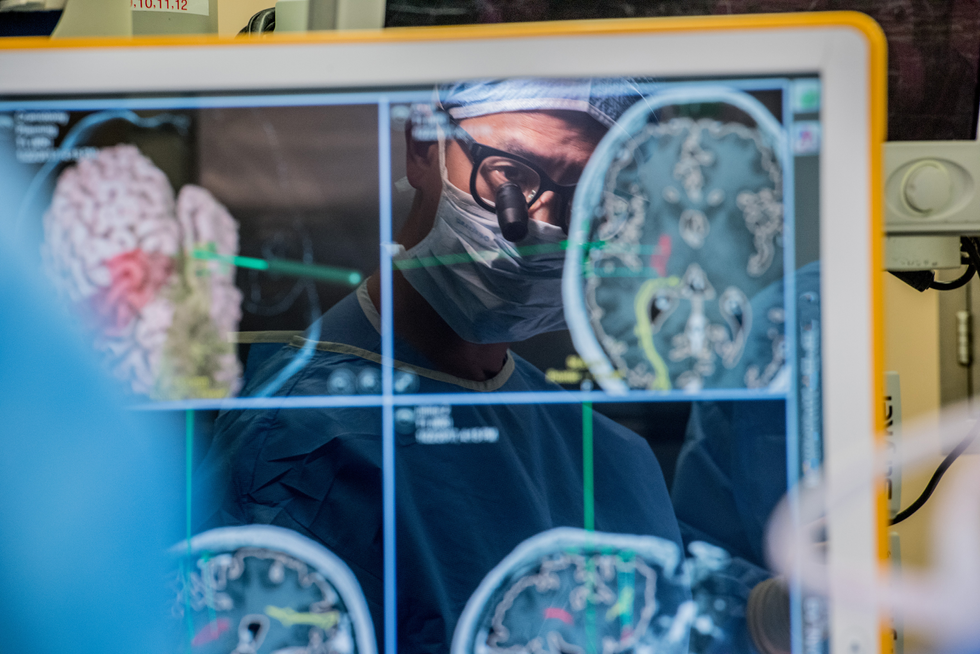 Edward Chang was encouraged to produce a mind-to-speech technique by the patients he encountered in his neurosurgery follow. Barbara Ries
Edward Chang was encouraged to produce a mind-to-speech technique by the patients he encountered in his neurosurgery follow. Barbara Ries
We feel that tapping into the speech method can supply even much better results. Human speech is substantially speedier than typing: An English speaker can simply say 150 text in a moment. We’d like to help paralyzed individuals to communicate at a price of 100 text for every moment. We have a ton of operate to do to get to that aim, but we consider our method would make it a possible goal.
The implant method is regimen. Initial the surgeon eliminates a modest portion of the cranium up coming, the adaptable ECoG array is carefully positioned throughout the floor of the cortex. Then a small port is fastened to the skull bone and exits through a individual opening in the scalp. We at this time will need that port, which attaches to external wires to transmit facts from the electrodes, but we hope to make the method wi-fi in the long term.
We have thought of applying penetrating microelectrodes, mainly because they can document from lesser neural populations and might consequently give additional element about neural activity. But the recent hardware isn’t as robust and harmless as ECoG for scientific apps, in particular more than numerous several years.
Yet another consideration is that penetrating electrodes normally have to have day by day recalibration to convert the neural signals into obvious instructions, and investigation on neural units has proven that velocity of set up and functionality reliability are essential to obtaining persons to use the technology. That is why we have prioritized stability in
making a “plug and play” program for extended-time period use. We carried out a research searching at the variability of a volunteer’s neural indicators in excess of time and discovered that the decoder executed improved if it applied information styles throughout various periods and a number of times. In machine-understanding terms, we say that the decoder’s “weights” carried in excess of, building consolidated neural alerts.
College of California, San Francisco
Because our paralyzed volunteers can’t speak when we view their mind designs, we asked our initial volunteer to try two distinctive techniques. He began with a list of 50 text that are helpful for each day daily life, these kinds of as “hungry,” “thirsty,” “please,” “help,” and “computer.” Through 48 classes in excess of a number of months, we sometimes questioned him to just visualize expressing every of the words on the listing, and in some cases questioned him to overtly
consider to say them. We discovered that tries to converse generated clearer brain indicators and were sufficient to teach the decoding algorithm. Then the volunteer could use those people words from the checklist to make sentences of his very own deciding upon, these as “No I am not thirsty.”
We’re now pushing to broaden to a broader vocabulary. To make that function, we require to continue to make improvements to the present algorithms and interfaces, but I am self-assured these advancements will materialize in the coming months and a long time. Now that the proof of theory has been proven, the intention is optimization. We can aim on making our system a lot quicker, far more exact, and—most important— safer and extra reputable. Issues must move swiftly now.
In all probability the most important breakthroughs will come if we can get a far better being familiar with of the mind techniques we’re attempting to decode, and how paralysis alters their activity. We have arrive to notice that the neural styles of a paralyzed individual who cannot ship instructions to the muscle mass of their vocal tract are quite distinct from all those of an epilepsy patient who can. We’re making an attempt an ambitious feat of BMI engineering when there is still lots to study about the fundamental neuroscience. We consider it will all arrive together to give our sufferers their voices again.
From Your Web-site Articles or blog posts
Relevant Posts Around the Internet

